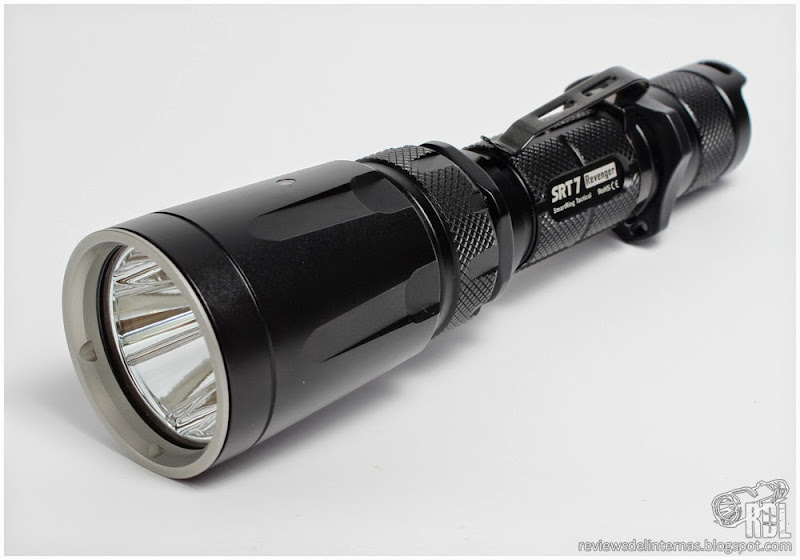
NITECORE SRT7 Revenger
LED : CREE XM-L2 T6 + 3x integrated RGB LEDs .
Battery: 1x 18650 / 2x (R )CR123
Modes: Variable magnetic control with fixed positions.
Switch: Forward in the tail , magnetic ring .
Date: April 2014
Links :
Banggood / Nitecore / RdL / ForoLinternas
INTRODUCTION:
One of the novelties presented escaped me long ago by the brand is the SRT7 Nitecore , tactical flashlight with dimensions and appearance similar to the Nitecore P25 design, but with two important factors not present in the Smilodon : Using a third generation magnetic ring, now called by the brand “Smart Tactical ring ”, and the new package incorporation XM -L2 , which if I remember correctly this was the first Nitecore to incorporate the second generation of the popular LED.

Nitecore had in past magnetic rings incorporated in different models. The first proposal of the brand dates from 2009 when its SR3 incorporated a detent ruled ring to select between different modes of fixed output. Two years later came the IFE2 , a much more compact than the SR3 flashlight powered by two CR123A or 18650, which instead of fixed output modes had a fully variable setting. This third generation of magnetic rings combines both proposals and offers a combination of fixed and variable adjustment modes by different areas of the dial ring is on its dial.

The Nitecore SRT7 comes in a card box according to the characteristics of other models of the brand. Inside are as well as the flashlight a set of replacement o-rings , a spare switch cover, a rigid plastic tactical ring , clip , paracord wristband strap, user manual and warranty card . It also includes a holster with velcro closure.

The holster has the peculiarity of being open at its bottom, leaving excel the entire tailcap.
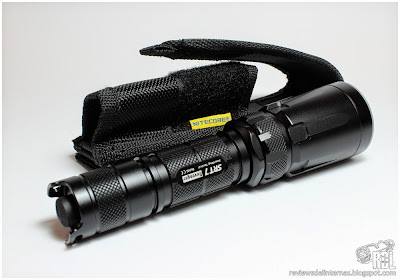

EXTERIOR FINISH:
The general and machining lines outside this SRT7 are reminiscent of the P25 , and in general to the great offer by many manufacturers of tactical-looking flashlights for a 18650 and a head diameter of about 40mm .


The exterior is nice precise and is free of machining flaws, sharp edges or other imperfections. The black anodized is a bit on the glossy side, something bright when compared to other brand flashlights as MT2C.

Another feature of the exterior finish is its dominant knurling , not too aggressive, but that added to the different body shapes make the SRT7 have a good hand grip . Also if we install the tactical ring will get an extra grip while it also will avoid the flashlight rolling.
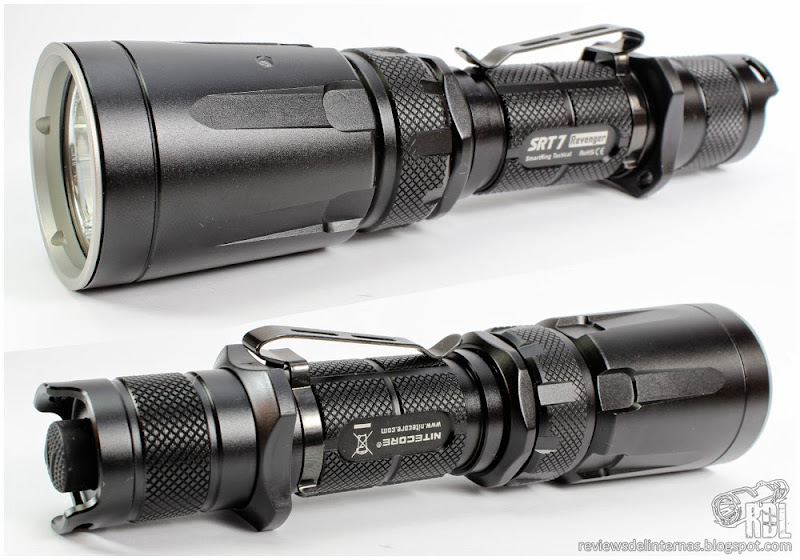
SRT7optics is similar to that of P25 , with the same ultra-flat steel bezel sandwiching a glass lens with anti-reflective treatment. The reflector has a new feature, and integrates three small LEDs in equidistant holes that are deep enough installed thus preventing XM-L2 light hitting them and creating shadows.


The driver has a system of protection against reverse polarity installed directly on the dock. It is a plastic disc to avoid contact with the negative pole of the battery if it is mistakenly reversed. This system can cause problems with flat -top batteries , or batteries with the positive top too small diameter. The battery space is generous, so nowadays popular protected batteries go smoothly. There is a small red LED installed on the side of the head, used as a low voltage warning and as a locator when the flashlight is in Standby mode.

The magnetic ring has an excellent finish , with easy machining drive through the different planes and overlying knurling . The dial is composed of a combination of detents, easy to notice to the touch, but dispenses with any visual indication .

Threads are finished in raw aluminum at its junction with the head , ensuring a reliable electrical connection and improved heat transfer .

The threads are cut square and smooth running even without being lubricated. The tailcap threads, these time anodized have a standard triangular cut to match the pitch of other families of the brand ( P , MH , MT , C … ) so that the remote switch is compatible .
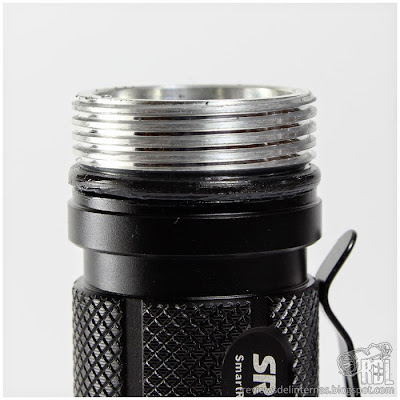

The design is identical to that seen tailcap in P25 , MT2C , CR6 … and has the same momentary switch .
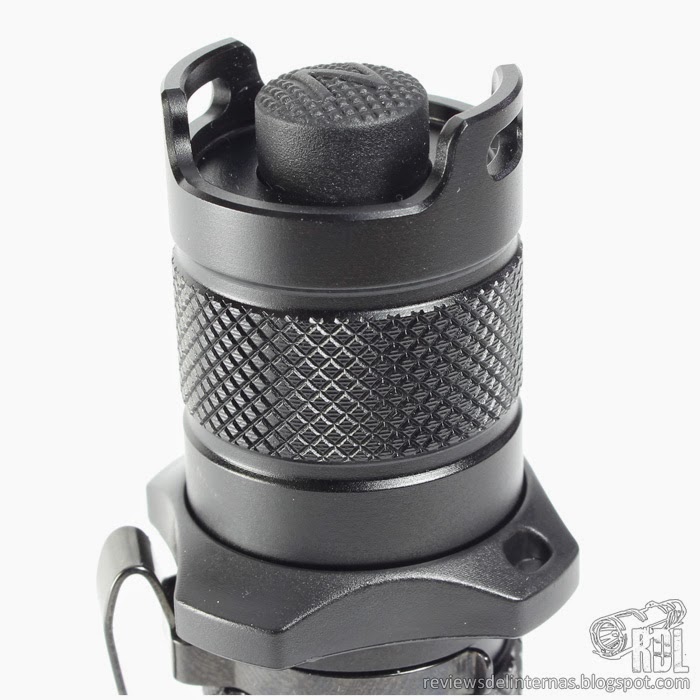
USER INTERFACE :
The SRT7magnetic ring, added to forward tailcap switch , make the experience of using this flashlight very satisfactory. The ring has approximately 360 ° degrees of rotation, with a fixed beginning and end. Within this dial, found several detents, points where the ring is fixed by the pressure of some internal mechanism , and wherein notice a click to enter and need to exercise a little more force to the next . Among these, we found a zone free of detents, designed for variable adjustment.
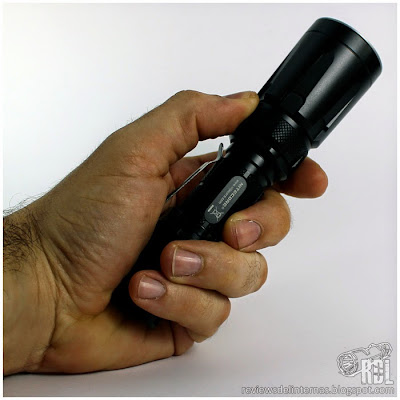
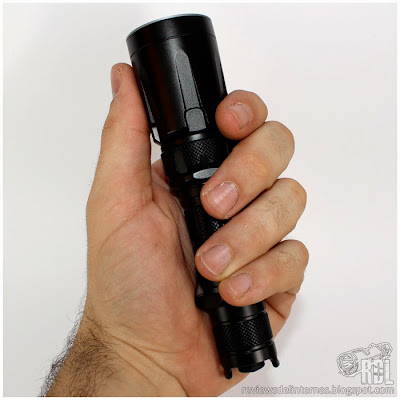
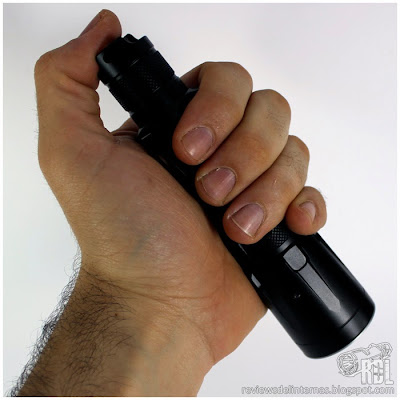
On and Off: The SRT7 is activated by a forward mechanical switch in tailcap . The mode correspond to control ring position.
Standby Position: Among the various ring detents, there is a postition that flashlight is virtually off, showing a flashing LED on the side of the head about three seconds each , very useful as a locator . When the flashlight is in this mode there is a small battery consumption to keep the system latency.
Variable adjustment: From the Standby position, turning the ring clockwise we enter the detent free zone in which you can adjust the light output of the flashlight from a range of 1.5 to 960LM . Upon reaching the maximum there is a detent that will be very useful if we want to use the flashlight like a “single-mode ”, with always the maximum power available and controlled by the tactical switch .
Strobe Mode : From the maximum output detent, there is a last position further to the right, where the strobe mode is . Again, the combination of control ring and forward clicky gives us the ability to be ready to turn on the flashlight in strobe (defensive or offensive use) directly from the tailcap switch.

Auxiliary color light: Returning to Standby poin , and instead of turning the ring clockwise, counterclockwise now . The first detent we found belongs to the red light, the next is for green light, and a detent more leads to blue light . This multicolor light produced by LEDs integrated into the reflector offers not comparable to the XM -L2 performance.

Police Strobe : The following detent counterclockwise from the blue light leads to a police strobe mode, where quick bursts of red and blue light alternate.
Beacon Mode: The last ring retainer counterclockwise is reserved for beacon mode , wherein the flashlight emits a brief but powerful flash of white light every two seconds, as a localization signal.
In general, SRT7 has a full user interface thanks to the combination of forward and magnetic selector switch is easy and intuitive, mastered in just seconds .
Instead of the typical bar graph showing the performance of each mode , I have prepared this where I have measured the performance of the variable output area in degrees. Inspired by the selfbuilt review, I have decided to make my own interpretation of the power curve of the SRT7. The dial of the ring in variable adjustment area is about 110 degrees. I measured in the field increased light output in 10 degrees, and then converted to percentage reflected in the graph , so that you can observe the curve LUMEN / DEGREES. That’s the curve which the sensor integrated sphere see, but not much like what I perceive to visually while rotating the ring … As SB points out , this curve does not correspond to the reality appreciated by the human eye, since our perception of luminance is not linear. In other threads there has been talk of this phenomenon, especially discussing the jumps between modes of different flashlights. According to Stevens ’ power law, our perception of luminance is similar to a cube root.
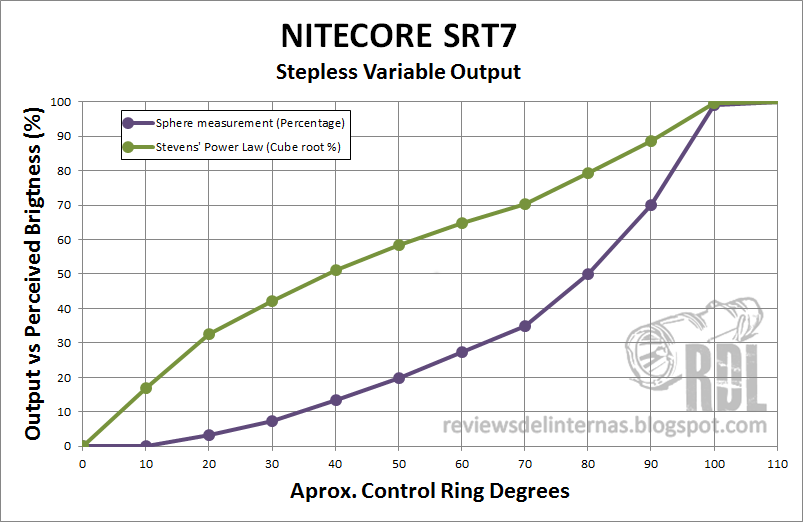
In the graph you can see that the purple line , corresponding to the reading of the integrating sphere, has a more or less linear increase in the first point , and quite pronounced in the last points, especially from 70 and up to 100 degrees . However, the green line offers a much more consistent linearity with what my vision perceives. The same applies to the first 30 degrees of the dial: The sphere hardly notices a numerical increase of 10 %, but my visual perception of the increase is much higher.
The variable mode setting SRT7 is just really good, and corresponds very well within degrees of turn and our visual perception.
PERFORMANCE:

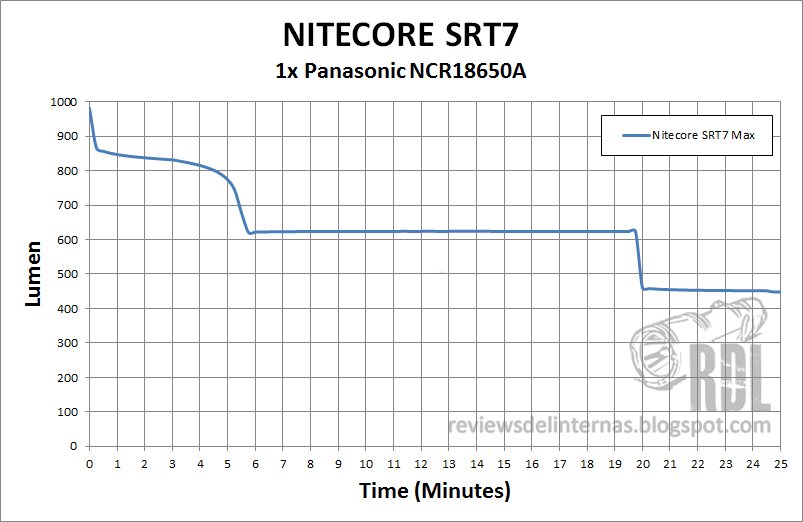
The SRT7 offers very similar performance to that we saw in the P25, even more powerful thanks to the new generation LED employeed. Something that although a priori it may not seem very appealing , but if we stop to check with the typical curves obtained by using magnetic rings is well above, with regulation at different stages including two time-controlled stepdowns .

As the huge runtime of P12 compressing lines in excess, I made a second capture of the comparing chart with time limited to two hours:

BEAM PROFILE:
Surprisingly, the holes in the reflector SRT7 show no traces of shadows or artifacts in the flashlight beam profile. The profile is very similar to that seen in P25 or EA4 because they share the same diameter and depth of reflector.
The tint is typical XM-L2 CW, with a slight greenish-to-yellow halo in the transition between the hotspot and spill.



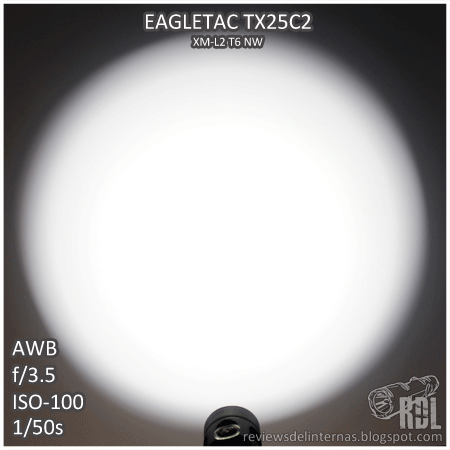


The beam of the auxiliary color LEDs show the typical signs of these three color LEDs, with a nice little combination of many artifacts and dark areas. By being integrated into the reflector, and proceed three separate emission sources such effects are multiplied by three.
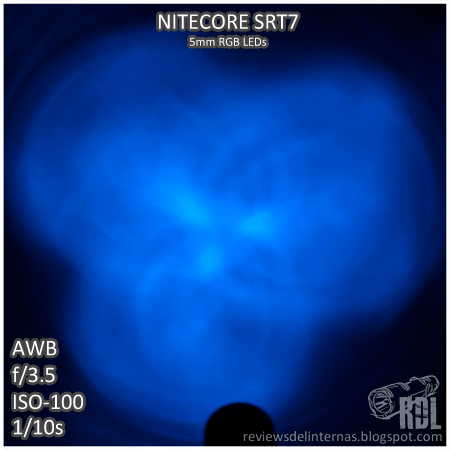

PERSONAL CONCLUSION :
Roughly the Nitecore SRT7 is a fantastic flashlight with a phenomenal finish and amazing functionality.


Nitecore P25, Nitecore SRT7, Rofis TR31C, Nitecore CR6, Olight M20, Fenix TK22
I dislike: The LEDs used for the multi - colored light . The integrated within the surface of the reflector if any merely magnify poor projection of these LEDs , creating a no-nice effect to the eye, especially on smooth surfaces . After seeing the most recent lauched HC90 , which Nitecore has changed the LEDs RGB per three LEDs each with a unique color, I hope this is a sign of change and in the future this type of design will be thing of the past . Another detail to improve is the complete absence of any visual indication of the positions of the magnetic ring . I would have liked to see an engraving in which the positions and indicator ring detailing for easy mode selection without having to turn on the flashlight.
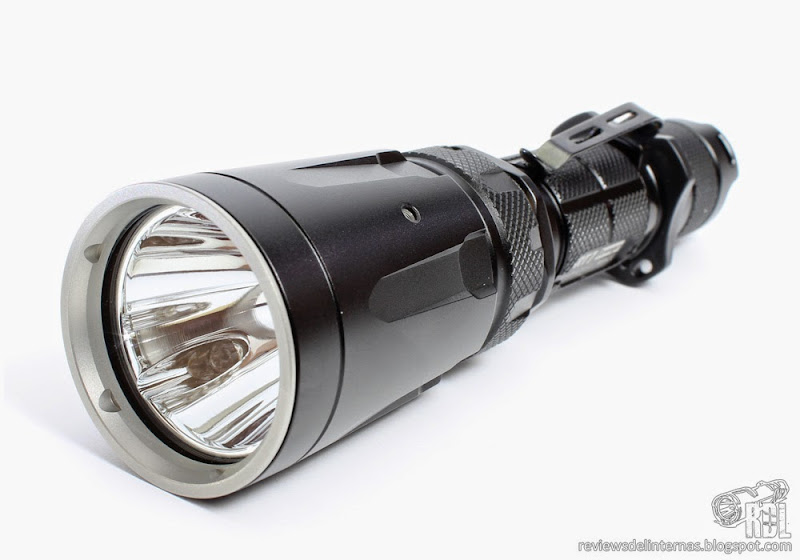
I like: I found the Nitecore SRT7 an excellent flashlight , robust finish and simple to use, with amazing versatility by combining classical and magnetic ring switch with variable adjustment and separate special modes. The feel and handling of the ring is great and adjusting the output power of the torch is carried out with precision , due to the visual linearity adjustment curve . I also like the standardization Nitecore seems to be carrying out their tailcap designs, allowing to use the same remote switch accessory in multiple flashlights . I really like the projection of white light is sharp without adverse effects by the incursion of the three RGB LEDs within its optic . Finally , it seems very successful to have placed the strobe modes at the ends of the dial, making sure not to have to go through them.

